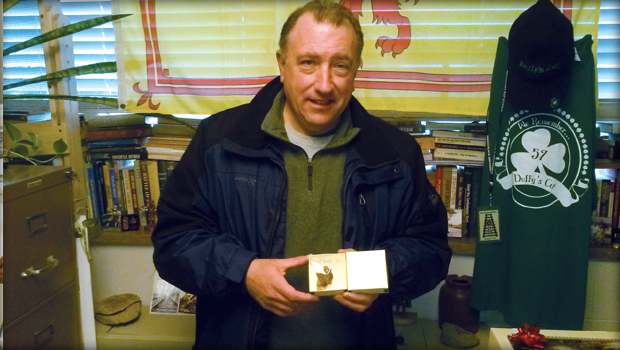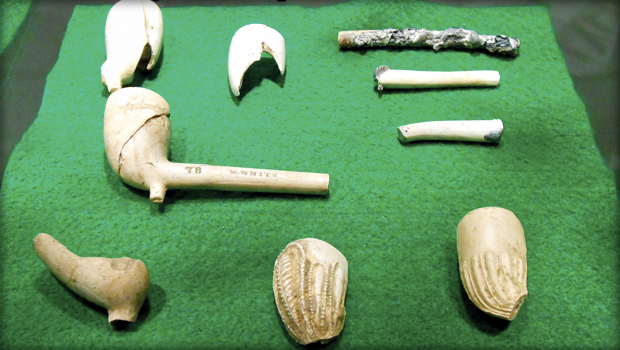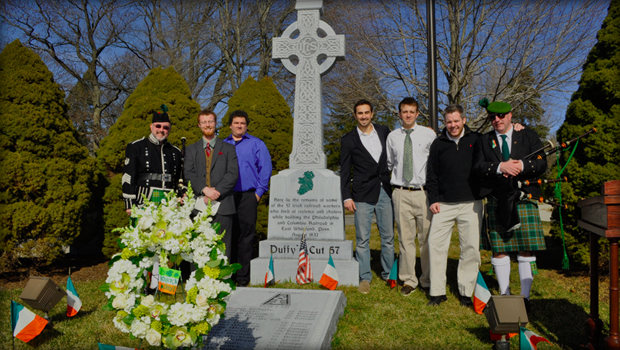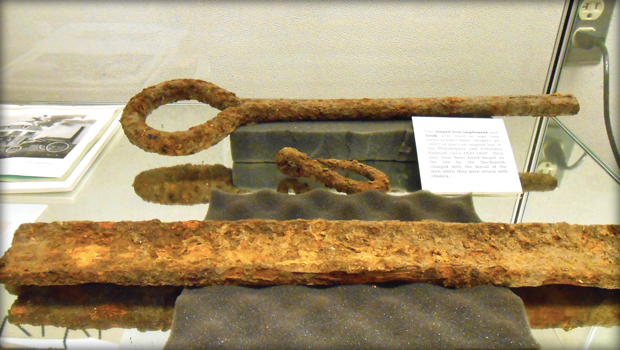Caption: In honor of the one-year anniversary of the burial and memorial service for five Duffy’s Cut workers, West Laurel Hill Cemetery hosted a Memorial Service on March 9. Among those attending were members of the excavation team (l. to r.) Rev. Dr. Frank Watson, Joe Conte, Charles Markward, Kris Panos, Taylor Sims, Matthew McStravog and Professor William Watson, chair of the History Department at Immaculata University. photo | Tom Keenan
By Marita Krivda Poxon
On a recent visit that I made to Immaculata University I spoke with Dr. Bill Watson about his ongoing historical detective work at the Duffy’s Cut site in Malvern, PA. Dr. Watson praised the soon to be released documentary, Death on the Railroad. Tile Films located in Dublin has made this film which was produced and written by Keith and Dave Farrell. Tile Films had made another television documentary film in 2006 called The Ghosts of Duffy’s Cut. As Dr. Bill Watson said: “We went to them (Tile Films) because they did such a good job on the first one.”

Dr. Bill Watson holds remains of man presumed to be John Ruddy which were buried in Donegal on March 2, 2013. Photo | Tom Keenan.
Dr. Bill Watson, professor and chairman of the History/Politics Department at Immaculata University, his twin brother the Rev. Dr. Frank Watson, pastor, Christ Lutheran Church, Whiting, NJ, and Earl Schandelmeier, adjunct professor of history at Immaculata, will fly to Ireland on February 27th, 2013. They will attend the March 2nd, 2013 reburial ceremony of the remains of a man presumed to be John Ruddy.
Ruddy was the 18-year-old Donegal-born immigrant who died at Mile 59 of the Philadelphia & Columbia Railroad — commonly known as Duffy’s Cut.
It had become expedient for the Tile Film crew to have the remains transported to Donegal so that this reburial ceremony at the Ardara Cemetery could be included in Death on the Railroad. When Bill Watson found out recently that the remains had cleared through Irish Customs and were on their way to Donegal, he breathed a sigh of relief. So did the Tile Film producers. The film will be released in America first and in the fall in Ireland through RTE.
The Watsons along with fellow historians Earl Schandelmeier and John Ahtes, began excavations at the site in 2004 and found human bones on March 24th, 2009. The remains found in total included two skulls, six teeth and eighty other bones. These two skulls showed evidence of violent, blunt force trauma.
In March 2011 the body of an Irish immigrant woman was uncovered. She is believed to be Catherine Burns who was murdered. On March 9th, 2012, the remains of five men and this one woman were given a Christian burial at West Laurel Hill Cemetery. A Celtic cross made in County Laois erected at the site bears the inscription:

Artifacts from Duffy’s Cut site include clay pipes embossed with shamrocks and harps. Photo | Tom Kenan
In his book-filled office at Immaculata, Bill Watson showed off a small box that contained a piece of John Ruddy’s jaw which would go with the brothers on their flight over. He said it was his insurance that some part of Ruddy would be buried in Ardara should the remains never make it through Irish customs or encounter some other mishap. The Very Reverend Canon Austin Laverty, a parish priest at Ardara’s Holy Family Catholic Church, will officiate at the reburial.
Direct descendents of John Ruddy’s father and uncle from the Donegal town of Inishowen will attend.
Philadelphia’s own Vincent Gallagher, president of the Commodore Barry Club, who is a native of Donegal, has donated a grave for the reburial.
Bill Watson also said that negotiations with Amtrak officials may hopefully reach a breakthrough soon. Bill reported a reversal in Amtrak’s position on the mass grave excavation at the Duffy’s Cut location. He is hopeful that his team will soon be permitted to do the final excavations at the mass grave.
For safety reasons members of the public will not be allowed on the site while the work is underway.
Geophysicist Tim Bechtel located this mass grave through his electrical imaging and seismic surveys at the site. The mass grave is 30 feet below the surface and adjacent to an existing Amtrak track on ground owned by Amtrak.
Bill Watson spoke about future locations where similar excavations would take place including Northwood Cemetery in Downingtown where there is a Potters’ Field with unmarked graves. The Watson brothers have gathered evidence that Peter Conner, another Irish contractor boss, employed a crew of Irish immigrant workers who also died in the 1832 outbreak of cholera.
This site poses fewer obstacles than Duffy’s Cut. The Watsons hope to document what happened to that crew of Irish workers.
Another site they are looking into is a Mennonite Cemetery in Spring City, PA where an outbreak of cholera killed Irish workers who were working on a canal.
Dr. Bill Watson gave me a tour of the Duffy’s Cut Collection of Artifacts excavated from the site on display at the Immaculata University library for a few years. Museum cases house old Irish-made clay pipes embossed with shamrocks and harps, a large forged cooking bowl found buried intact, hand forged nails (many used to nail shut coffins) made by Malachi Harris, the camp’s blacksmith, iron implements used to lower stone sleepers onto the original iron track line, and a very rare piece of Morris & Essex-type cast iron track. The only other known such track is housed in the Smithsonian Museum.
The Watson brothers have been approached by commercial shows like the “History Detectives” and “Ghost Hunters” to sell their story. Dr. Bill Watson and his brother Frank are adamant that they themselves want to uncover the historic truths of Duffy’s Cut.
Their own family story has been part of Duffy’s Cut since their grandfather Joseph F. Tripician preserved Pennsylvania Railroad files. He recounted Duffy’s Cut legends and stories to his grandsons. Dr. Bill Watson talks of “the boys” like they are his own brothers. His affinity to their humanity is apparent when he speaks of them. No one but he, his brother, and Earl Schandelmeier will take these boys home to a respectful burial site and to an honored place in Irish American history.
Marita Krivda Poxon is the author of Irish Philadelphia.


